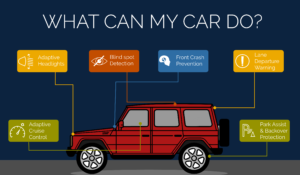
Active and passive features are making cars safer.
Imagine driving in a vehicle with an unpadded steel dashboard and just lap belts in the front seat – belts that were typically buried in the seat because nobody used them!
Imagine a world without car seats, headrests and shoulder belts. Imagine no airbags, no ABS brake systems, and no passenger side mirror. Imagine a car without cup holders! For people over 60, these were realities as they grew up to become drivers.
The automotive industry has certainly adopted safety technology and improvements since then. Much of this equipment is known as “passive safety” enhancements: things that improve the safety of occupants through fixed components of the vehicle such as airbags, seatbelts and the overall physical structure of the vehicle, designed to better protect occupants during a crash.
Now there is an explosion of new technology enhancements defined as “active safety” or “crash avoidance” technology that assists operators in the prevention or avoidance of a crash.
Examples include:
- Adaptive cruise control
- Adaptive headlights
- Blind spot detection
- Front crash prevention
- Lane departure warning and prevention
- Park assist and backover protection
These features are all designed either to enhance the driver’s ability to recognize a potentially dangerous situation or to trigger automatic avoidance measures. For example, blind spot detection alerts the driver to a vehicle traveling in the blind spot. Adaptive headlights enhance headlight function on rural roads. Front crash prevention systems recognize an imminent crash situation and either alert the driver or trigger automatic avoidance measures, such as braking or reducing speed. How these systems work can be a little more difficult to understand.
The Insurance Institute for Highway Safety has developed a website to assist drivers in better understanding the benefits of these enhancements. The site also allows you to search by vehicle make, model and year to determine what technology is available on specific vehicle models. Consider this technology when shopping for a new vehicle.
Oh by the way…
- Cup holders were standard fare by the early to mid-1980s, driven mainly by the success of the minivan in the U.S.
- Lap belts were required in front seats after January 1, 1965.
- The first U.S. law requiring seat belt use in passenger cars was passed in New York State in 1984.
- The first federal safety standards for cars became effective January 1, 1968. These standards helped protect drivers against unreasonable risk of crashes occurring as a result of the design, construction or performance of motor vehicles. These required shoulder belts for left and right front-seat vehicle occupants, side marker lights, collapsible steering columns, and other safety features.
- 1969 saw the addition of head restraints for front passengers, addressing the problem of whiplash in rear-end collisions.
- Effective in 1968, U.S.-market passenger cars were required to be equipped with padded instrument panels, front and rear lap belts, as well as many other enhancements.
- Airbags were first installed in production vehicles in the 1980s as standard equipment instead of an option. Frontal air bags have been standard equipment in all passenger cars since model year 1998.
- The first child passenger safety law was enacted in 1978 in Tennessee to require parents to place their young children in an approved child restraint system.
MORE INFORMATION
Child car seats: Precious cargo packaging
This loss control information is advisory only. The author assumes no responsibility for management or control of loss control activities. Not all exposures are identified in this article. Contact your local, independent insurance agent for coverage advice and loss control services.
